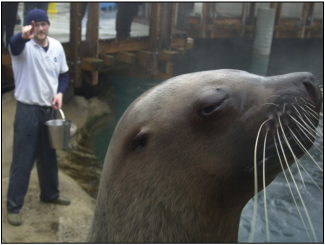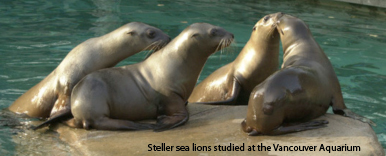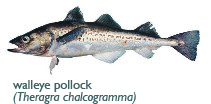
Like most mammals, Steller sea lions require varying amounts of food throughout the year, according to such appetite-influencing factors as age, sex, and the reproductive cycle. Yet the availability of sufficient food in any given season is beyond their control, and a shortage of prey in a time of great energetic need can lead to long-term health effects.
How might recent changes in the availability of key prey such as walleye pollock, a major winter food source for Steller sea lions in western Alaska, affect the sea lion populations that depend on them? Could the seasonal pollock fishery play an exacerbating role? Little is known about how critical prey shortages affect the physiology of individual sea lions in each season.
To this end, Consortium researchers worked with captive Steller sea lions to study their hormonal levels – which mediate seasonal changes in physiology – in response to periods of food restriction across all seasons. The results of the study, by David Rosen and Saeko Kumagai (of the Marine Mammal Research Unit at the University of British Columbia), are published in the Journal of Comparative Physiology B.

The Role of Hormones
A previous study by the authors found that when captive Steller sea lions were subjected to short-term periods of food restriction, they lost more body mass in winter than in other seasons. The current study examines the seasonal relationship between key hormones and physiological changes (in body mass, body composition, and metabolism) during periods of food restriction. The researchers studied seasonal differences in initial levels of three hormones (triiodothyronine or T3, thyroxine or T4, and cortisol) and one blood metabolite (blood urea nitrogen, or BUN) in captive Steller sea lions. Cortisol is usually elevated in response to stresses such as a restricted diet or increased mass loss. Similarly, elevated BUN levels have traditionally been used as an indicator of nutritional stress in wildlife management. The principal thyroid hormones, T3 and T4, affect metabolism in mammals and can alter growth rates.
Competition for Prey
The sea lions were fed restricted diets for up to nine days in each season and lost an average of ten percent of their initial body mass. “Overall, restricted energy intake during the winter resulted in the greatest decreases in T3 and body mass and the greatest increases in cortisol and BUN, and the opposite results in summer,” the authors write. “This suggests that the Steller sea lions had a greater physiological reaction to food restriction during colder seasons (non-breeding seasons), and that they were probably less impacted in warmer seasons (breeding seasons).”
 Importantly, the study suggests that sea lions may be more physiologically susceptible to short, severe reductions in prey during the winter, which coincides with the timing of the Alaskan pollock roe fishery. This also corresponds to the time of year when pollock densities may require sea lions to forage for longer and to consume more pollock prey to meet their higer seasonal energetic needs.
Importantly, the study suggests that sea lions may be more physiologically susceptible to short, severe reductions in prey during the winter, which coincides with the timing of the Alaskan pollock roe fishery. This also corresponds to the time of year when pollock densities may require sea lions to forage for longer and to consume more pollock prey to meet their higer seasonal energetic needs.
“Thus, while competition between fisheries and sea lions is still a contentious hypothesis, the potential effects of such interactions would appear to be greater in the winter,” the authors note.
These results serve several important purposes. They provide a clearer understanding of the underlying physiological responses and bioenergetic priorities of Steller sea lions at different times of year, and they also test the ability of certain blood parameters to be used as indicators of nutritional stress. Finally, they can be used to help refine current fisheries legislation by offering empirical experimental results. Together, this represents a valuable contribution toward measuring and identifying nutritional stress and its underlying causes among populations of wild Steller sea lions.
PUBLICATION
[webref_pretty title=”Hormone changes indicate that winter is a critical period for food shortages in Steller sea lions”]
